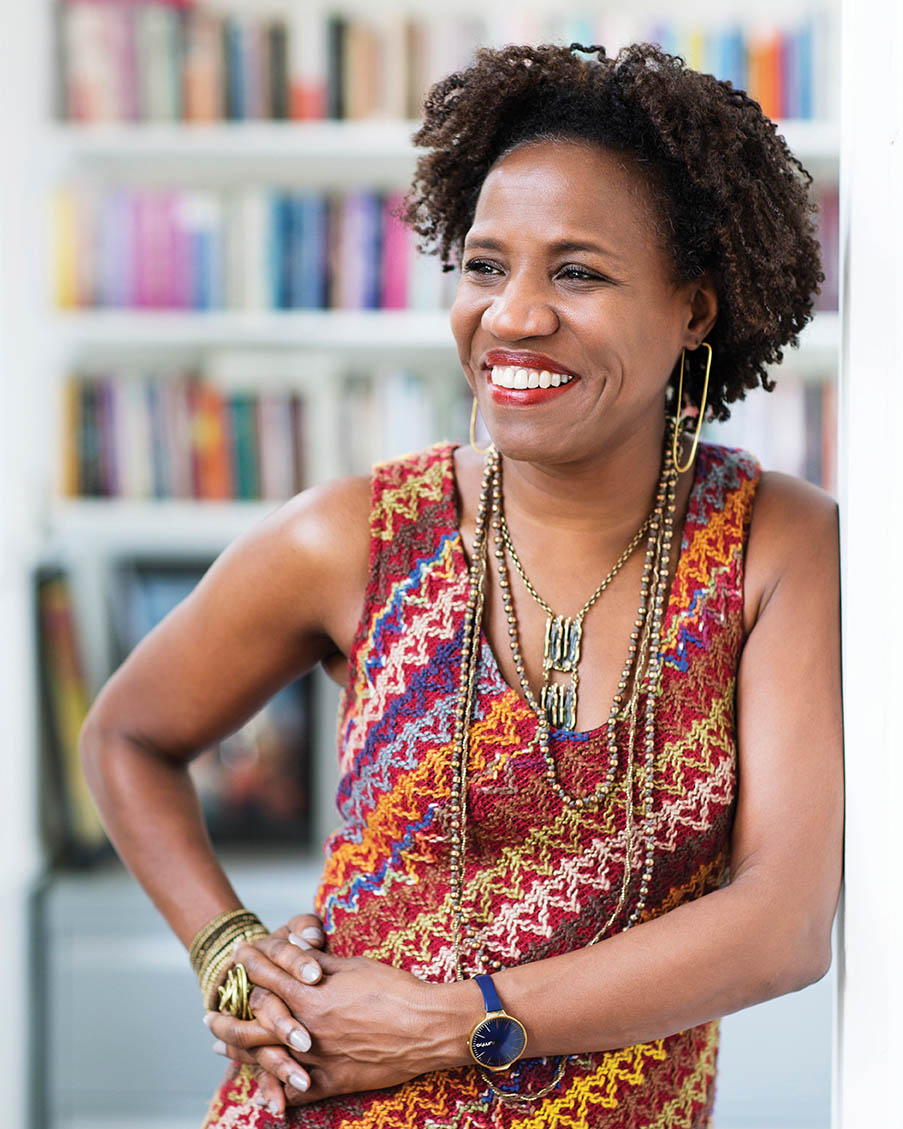Professor Tina Campt doesn’t have to look far for inspiration. The neighborhood of Harlem, right in Barnard’s front yard, has always played an important part in the curriculum of the Africana studies department, where Campt has taught since 2010 and which she has led since 2011. Now, Harlem is once again providing a rich resource for learning through a new series of academic courses.
The Harlem Semester offers students an academic immersion in Harlem in partnership with the institutions and people that have made the neighborhood a thriving political and cultural center for the African diaspora. This spring, six courses were taught in conjunction with—and for several sessions at the site of—five venerated Harlem arts and cultural institutions: Harlem Stage, the National Black Theatre, the Romare Bearden Foundation, the Schomburg Center for Research in Black Culture, and the Studio Museum in Harlem. The initiative was organized by Africana studies and the Barnard Center for Research on Women, where Campt has been director since 2014.

More than 120 students took the courses, which will expand next year to include another Harlem giant: the Apollo Theater. Arts spaces have been central to Harlem’s history, enabling it to become a place that is unique to the African American identity.
“The courses that comprise the Harlem semester celebrate where we are in New York City and the unique connections between Barnard and Harlem,” says Linda Bell, provost and dean of the faculty. “Beyond that, they are about place-based learning outside of the four walls of the classroom.”
The initiative unites site-specific learning with a collaborative approach to teaching. Experts at the partner institutions—curators, archivists, artists, and administrators—co-taught the classes, engaging students in discussions of the history of the institutions and their contributions to the cultural landscape. The students made use of rare archival materials and had behind-the-scenes access to museums, theatres, and art collections. They went on themed walking tours designed for each class to show them the places that the authors and artists they were studying captured in their work.
“I honestly didn’t really know much about Harlem before,” says architecture major Joud Al Shdaifat ’17. “Now I know Harlem is one of the most creative, eclectic, sacred places that I’ve been to in New York.”
Sade Lythcott, CEO of the National Black Theatre, says, “Students are learning firsthand from institutions that have been on the frontline of making Harlem one of the most important and culturally rich communities in America, and as the institutions, we have gotten a profound opportunity to tell and teach our stories to the next generation of thought leaders.”
The classes drew on numerous themes: art, activism, literature, architecture, religion, and other subjects. Students made architectural renderings for a new building for the National Black Theatre; explored art and social justice during the Harlem Renaissance; created digital storytelling projects in collaboration with the Schomburg Center and the International Center of Photography on the work of playwright and poet Ntozake Shange ’70; participated in a master class with the creator of a new work about James Baldwin; studied the archives of artist Romare Bearden; and examined their own subjectivities in response to a seminal 2001 exhibit at the Studio Museum in Harlem.
Students read works by Baldwin, Langston Hughes, Zora Neale Hurston ’28, and others, and learned how the authors interacted with Harlem: where they lived and how they were influenced by the people and the culture.
“In order to understand Harlem, you have to understand the community and its relationship to this place,” says Campt, who is the Ann Whitney Olin Professor of Africana Studies and Women’s, Gender, and Sexuality Studies.
In her role as chair of the Africana studies department, Campt frequently hosted prominent scholars who teach and speak about Harlem, which prodded her to think about creating a more formal way for students to study the cultural and political legacy in and around Harlem. “I thought we could give back to that community by partnering with the people in that community to teach their history and their legacy, and to teach what is in our front yard.”
Campt reached out to Columbia’s School of the Arts and, with their help, she presented her idea at a meeting of 15 arts and cultural organizations in Harlem. It was a hit. Pat Cruz, who is the executive director of Harlem Stage, recalls telling Campt, “This is the kind of partnership we have always dreamed about having with a university but never did. And we have it with you, and we love that!”
Many of Harlem’s prominent institutions were founded or are run by African-American women, and they are especially interested in nurturing Barnard students, says Campt, who wanted to “make visible the role of African-American women in Harlem as cultural leaders, sustaining the institutions that make Harlem great.”
Taking classes at these institutions afforded students an opportunity “to appreciate the richness of the area’s history,” says Irina Verona, an adjunct assistant professor who taught an architecture class in conjunction with the National Black Theatre, one of the oldest black theatres in the country. “Harlem has a unique mixture—politics, culture, and religion are intertwined.”
Victoria Lee ’17 says the course on the Harlem Renaissance prompted her to consider “which narratives and voices are given space in Harlem.” Attending performances at the National Black Theatre showed her how the theatre’s “approach to its performances and its audience diverges from mainstream theatre productions in a refreshing and incredibly thought-provoking way.” Spending time at Harlem’s most renowned institutions, she says, “has changed the way I see my neighborhood.”
